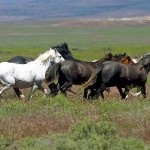
Dear Friends of America’s Wild Horses,
These are remarkably trying times, considering the recent deaths of our wild horses in the West. Despite a public outcry against the massive and dangerous roundups of these treasured animals, the Bureau of Land Management is pressing forward, leaving the broken bodies of our mustangs in their wake. When we have unpreventable disaster like earthquakes and hurricanes, it is indeed frustrating to watch a man-made disaster unfolding on our public lands in the West against innocent wild animals who only want to live in peace with their families.
Despite our anger at being ignored by the Department of the Interior and the Bureau of Land Management, we must not let our emotions get the best of us. Any thoughts of violent actions or illegal behavior of any kind need to be put out of our heads. Instead, we must focus on legal methods to make a difference. Here is what you can do right now, today, and for the weeks and months that follow.
Continue reading Seven Horses Die Following Day One of Nevada Roundup



